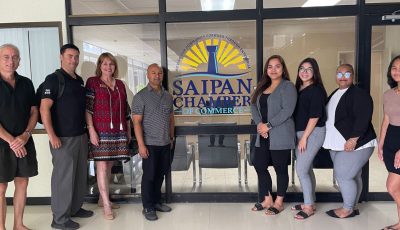MICRONESIA CHALLENGE
A shared commitment to conserve
The Micronesia Challenge, an over-arching environmental project to promote conservation and wise development of coastal resources in Micronesia, is a model for similar conservation efforts across the world.
If current conservation actions under the Challenge continue, the CNMI will achieve the goal of effectively conserving 30 percent of its coral and benthic habitats by 2020.
Managed by the Division of Coastal Resources Management under the Bureau of Environmental and Coastal Quality in the CNMI, the Micronesia Challenge was created in 2006 as a concerted effort by the Federal States of Micronesia, Republic of the Marshall Islands, Republic of Palau, Guam, and the CNMI to preserve the natural resources that are crucial to the survival of the Pacific traditions, cultures, and livelihoods.
The overall goal of the Challenge is to effectively conserve at least 30 percent of near-shore marine resources and 20 percent of terrestrial resources across Micronesia by 2020.
The Micronesia Challenge works to protect and preserve 6.7 million square kilometers of the Pacific Ocean, 66 species in Micronesia that are on the red list of the International Union for Conservation of Nature, 1,300 species of fish living in the waters of Micronesia, 483 species of corals, 1,400 species of plants, 85 species of birds, and 104 of the 218 recognized Endemic Bird Areas confined entirely to islands of the world.
Positive results
The Micronesia Challenge in the CNMI has already resulted in positive outcomes and gave opportunities to acquire solutions.
Currently, the CNMI has already achieved the terrestrial goal of the Micronesia Challenge with 22 percent of its land area in designated conservation areas. The challenge to reach the goal of effective conservation is a work in progress as poaching and poor land practices are current deterrents.
The goal of effectively protecting 30 percent of CNMI’s fish species and population has been reached, according to the Department of Fish and Wildlife, because of current restrictions and regulations such as SCUBA spear and gill net fishing bans.
The goal of effectively conserving the CNMI’s nearshore benthic and coral habitats has been reached by 18 percent due to the adoption of a watershed on Rota and Long Beach and Taga Beach on Tinian.
The CNMI Marine Monitoring Team believes that, if current conservation actions in these watersheds continue, the CNMI will achieve the goal of effectively conserving 30 percent of its coral and benthic habitats by 2020.
Aside from its mandated conservation plans, the Micronesia Challenge is active in outreach events and presentations involving the youth, giving education to lessen tourism related impacts and conservation efforts with the Micronesia Islands Nature Alliance.
With the help of the CNMI’s 6th Micronesia Challenge Young Champion, Katelyn Delos Reyes, awareness and promotion of the objective and purposes of the Micronesia Challenge has gained exposure. Delos Reyes works as an ambassador, introducing the community to the Micronesia Challenge and explaining its impact in the CNMI by making presentations and designing stickers to give away as incentive after every presentation. She has taught over 1,000 students and community members about the importance of the Challenge.
Delos Reyes played an integral part during the Timmy Would Go Memorial Paddle Classic and at the My WAVE Summit, speaking to various groups about the Micronesia Challenge and assisting her mentor in educating the public about the many ways to lessen tourism related impacts in the CNMI.
Delos Reyes also did outreach presentations at Kagman High School and Oleai Elementary School.
MINA
A leading environmental conservation group in the CNMI, the Micronesia Islands Nature Alliance, included the Micronesia Challenge as part of its conservation goals since 2008.
MINA’s contributions to the Micronesia Challenge include projects such as the Marine Debris Prevention Outreach, Adopt-A-Bin recycling program, Environmental Camp that encourages schools, the TASI Watch project that fosters community-based environmental stewardships, the Managaha campaign that raises awareness of the CNMI’s marine protected areas, and the Plastic Bag Challenge to discourage the use of plastic bags in stores and businesses throughout Saipan.
MINA also played a key role in the coordination of SEM-Pasifika workshops across the region, building capacity in socioeconomic monitoring. A SEM-Pasifika training will take place in Tanapag in upcoming months.



























